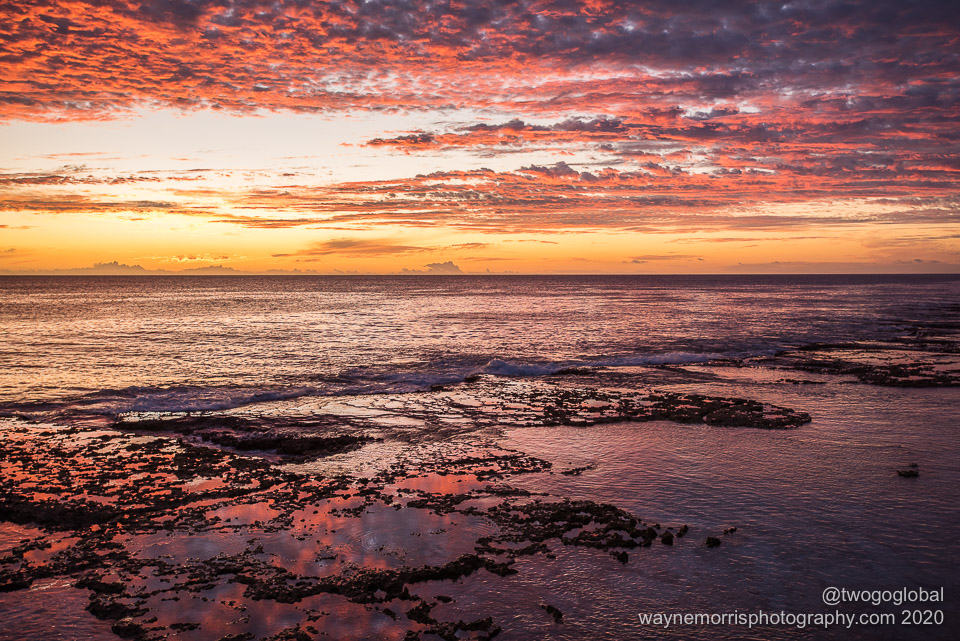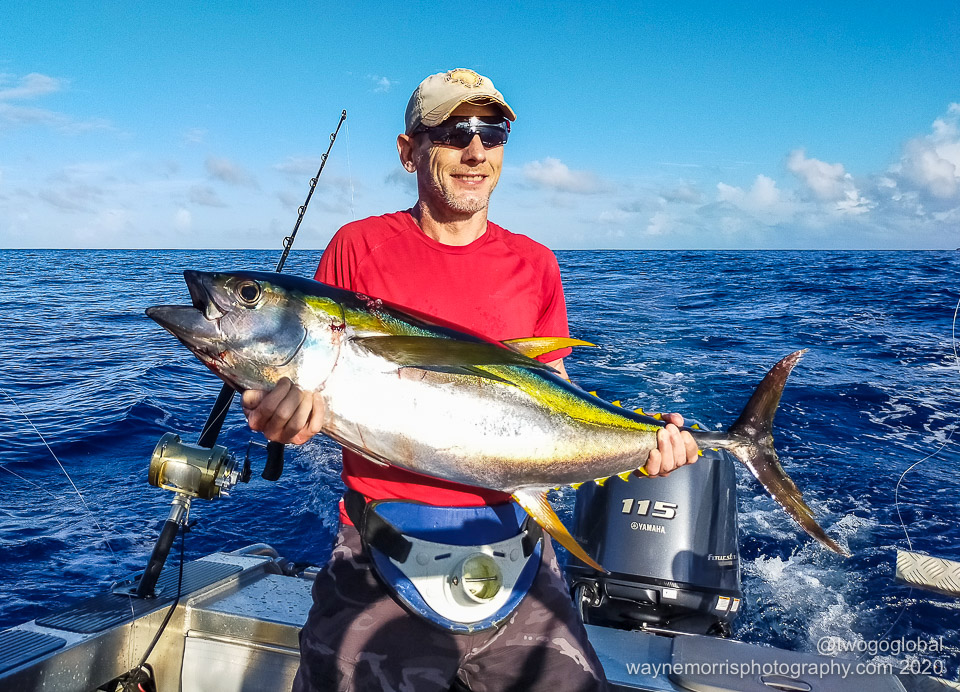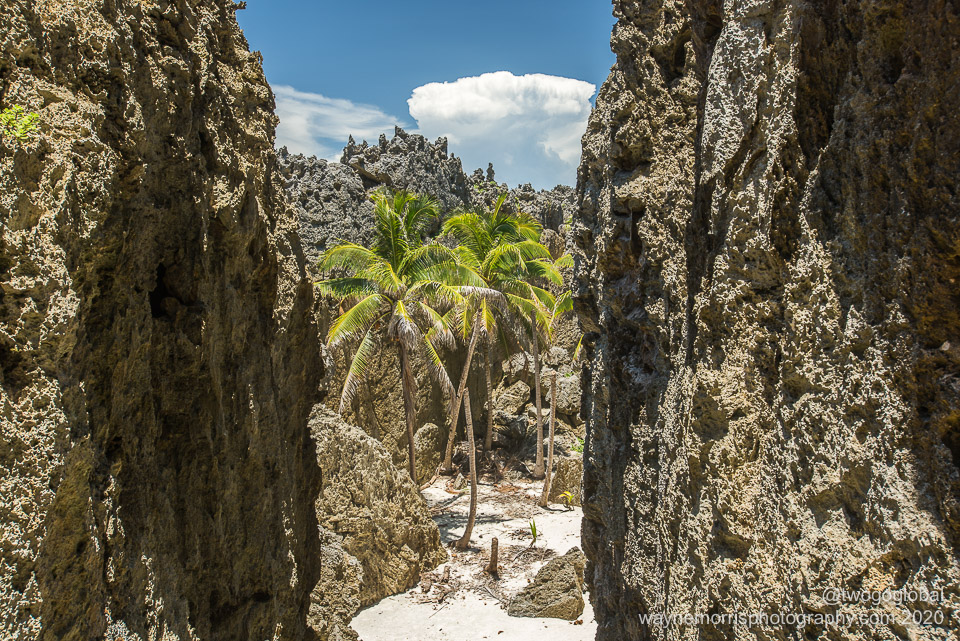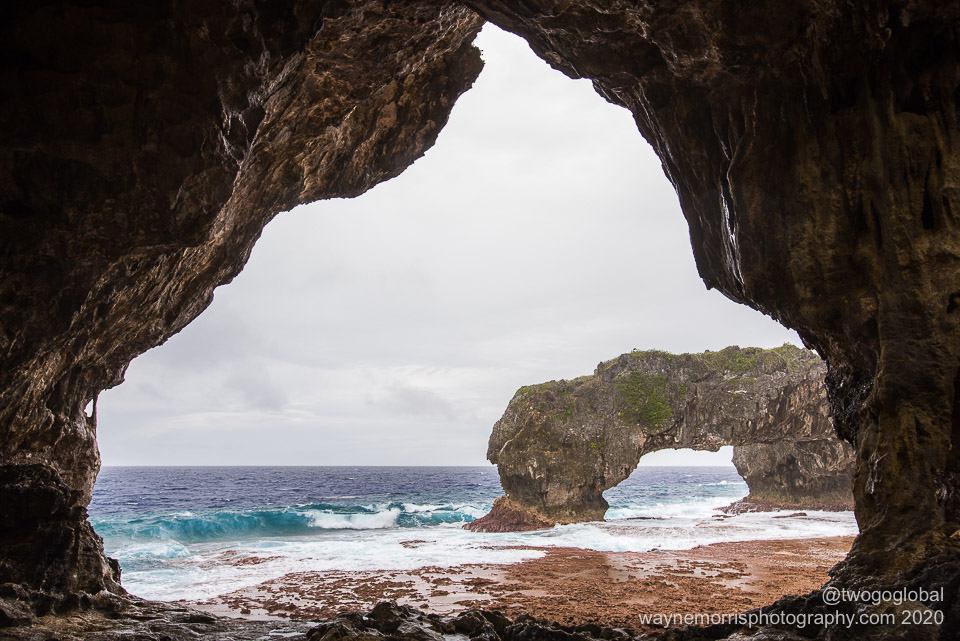Niue must have one of the smallest international airports on the planet, and only having to cater for a single airline with twice weekly flights it was easy to see why – all of the staff are probably part-time, working at the local golf course or as police officers the rest of the time. On ‘plane’ days the island becomes a hive of activity; with a slightly bigger than tiny market, tour companies plying for the little off-season trade, and rental vehicles relocated to the airport for arriving passengers.
Even though the island was small the smiling Niueans were on the ball, with no baggage holdups, no hassle from stressed immigration officers and no quarantine inspector doing everything in their power to separate us from the food we had bought over from New Zealand! Our life for the next 10 days was going to be easy – the hardest thing was going to be navigating our way through the islands road system, or lack of!
Getting from the airport involved 15 minutes of pothole dodging driving, a task that got slightly easier as we became familiar with the route through them – head left at the double wide hole, then immediate right at the tire guzzling deep one, a little further right onto the properties grass, then all the way left to avoid the triple bouncer. And on it went as the suspension took a constant pounding.
Being a family vacation we opted to stay in a villa belonging to the islands only resort, Scenic Matavai. This self catering accommodation was situated a mile along the islands ring road system from the main resort and came with its own shared pool, shuttle bus and daily cleaning service. What it didn’t come with was an ocean view and a gun to keep the noisy roaming dogs away!
Self catering was the way to go as we had the ability to prepare and cook our own meals, a compliment to eating out at the very few open restaurants on the island. The main problem with this was the lack of fresh produce and supermarket food options – we could see papaya and coconuts everywhere we went but other than a couple of root vegetable varieties the selection of locally grown stuff was severely lacking. We had bought with us almost 2 kgs of blueberries, 10 kiwi fruit, wraps, oats, coffee, tea, and a few other items we were fussy about and hoped that there would be an okay selection in the ‘main’ Alofi town supermarkets. Unfortunately, reliant on New Zealand for its monthly delivery ship and air cargo clearly showed in the lack of food items.
What appeared much better was the availability and duty free prices of gin, wine and beer – we weren’t going to go thirsty!
After settling in it was time to head over to the resort for a welcome cocktail, a low key event this time of year where we were greeted by the staff and a couple of tour guides. Keith, the Kiwi owner of Niue Orientation Tours and Vanessa, a Niuean owner of a family run guiding and fishing company were waiting their turn in telling us a little about their offerings.
Keith and Vanessa both sold well, with our island orientation scheduled as per normal for the day after arrival and a deep sea fishing trip a few days later. The deep seas off the shore of Niue begin within tens of metres, totally unlike our last outing in Costa Rica where we would be many miles out at sea. As well as these planned events we had plenty more days for discovery which would include chasms, snorkeling holes, and mountain biking.
Before going into what we found were the highlights of Niue lets look at some facts…
-
- Covers a land area of approx 260 sq km or 100 sq miles
- Is a self governing state in free association with New Zealand
- Sits 2,400 kilometres (1500 mi) northeast of New Zealand
- Has a ring road around the island of 64 kilometres
- Is commonly referred to as “The Rock”
- Has a highpoint at 69 metres above sea level
- Was heavily damaged by Cyclone Heta in 2004
- Has a population of approx 1500, down from 5000 in the 1960’s
- Fifteen times more Niueans live in New Zealand than in Niue
- All Niueans are automatically New Zealand citizens
Niue Orientation Tour
After an island briefing from Keith it was time to head off in search of the highlights, mostly those on the more populated west coast where calmer seas allow for some epic snorkeling spots. Driving south from Matavai our first stop was Avatele (pronounced Avacele); a decent place to snorkel, grab food and drink at the Washaway Cafe honesty hangout (only open Sundays but closed when we visited due to damage from recent Cyclone Tino), and also due to wharf damage from the same cyclone now home to the islands main boat ramp. We would later revisit Avatele numerous times to snorkel.
From there we returned north and after a quick stop at Tamakautoga to check out its small pools and reef walk we headed into the islands capital of Alofi – barely a blip compared to even the smallest towns in other parts of the world, but still home to Swansons and a couple of other smaller supermarkets, various restaurants, an outdoor market, a couple of vehicle/ bicycle rental companies and a gas station – a pretty good infrastructure considering the islands local and tourist population. Close to town are the government offices, by far the islands biggest employer, the airport, a newly built police station and a decent bakery.
With no need to shop we continued north stopping first at Avaiki Cave, an easy and short walk through forest leading into the cave on a newly damaged boardwalk, the cause due to high water from Cyclone Tino. Keith, our guide, pointed out that usually the wooden steps and walkway lead down to a small snorkeling hole and at low tide continuing on as a reef walk to Palaha Cave. Andrea and I would later revisit the cave, scramble around the damage, and make the reef walk. A short 5 minute drive took us to Hio Beach, an amazing place to snorkel in azure blue pools when the tide and swell permit – this was definitely not the case on this day where the incoming tide would push and pull anyone adventurous enough to jump in back and forth across the shallow reef! We noticed that this was very common in many of the popular snorkeling pools during our stay on the island.
From Hio the ring road took us almost to the top of the island to a place called Matapa Chasm, another popular snorkeling hole for both tourists and locals. Accessible by walking 10-15 minutes down the Hikutavake sea track the chasm is flanked on both sides by cliffs, the narrow body of water well protected from the ocean. What we did notice here was a mixing of fresh water from the islands caldera with salt water, the result not only colder water but significant distortion causing very limited visibility. Also at the start of the Hikutavake sea track access is possible to Talava Arches.
After checking out mountain bike rentals at Namukulu Cottages, also in the far north, it was time to head back to Matavai and an end to the Niue Orientation Tour. Listening to Keith’s stories and advice on other places we should visit whilst on the island made the day interesting and humorous, worthy of the reasonable price tag.
Fishing with BJ
Our second tour moved from land to water, this time to catch us some dinners. BJ’s name came up numerous times and being promoted by his wife, Vanessa, at our Matavai welcoming it seemed like a no brainer to head out onto the water with him. Due to the damage at the islands wharf in Alofi we met at the very rustic boat ramp in Avatele – access through the shallow water had been enabled by the opening of a narrow channel out into the open ocean. Fortunately for us this wasn’t the first time through these awkward waters for BJ and we were soon out in 100 metres of ocean within spitting distance of shore!
With 5 rods baited differently to attract tuna and wahoo we were soon off trawling along the coastline, sometimes circling the DAFF provided floating platforms that attract the smaller stuff and sometimes checking out bird activity that could indicate schools of bait fish. We weren’t disappointed and typically had more than one rod screaming and bent over at once. Reeling in multiple fish was challenging but with an end count of eight yellowfin tuna and an amberjack, well worth it! Being on vacation the hard part was not getting to keep all the fish – oh well, we did get to take back to Matavai more than enough for multiple dinners and plenty of sashimi snacking. Splitting the 500 NZD cost between the three of us was good value for over four hours out on the water.
The remainder of the island hotspots were reached either by our rental vehicle or the mountain bikes from Namukulu Cottages. The almost new bikes were a snip at 100 NZD per person for an entire week. Alongside bikes Namukulu and its Kiwi owners have some pretty amazing looking cottages, manicured gardens and a very inviting pool – well worth a look for accommodation in the north.
The rest of the hotspots
We found that to hit the sights along the sparsely populated east coast, with its extremely poor section of ring road, it was easier by vehicle. This involved a day trip and a full circumnavigation of the island.
First off it was tackling the 155 slippery steps leading down to Anapala Chasm. These were accessed by a short forest walk which eventually led down to a very narrow chasm, the bottom filled with fresh water. Of course Andrea had to get right on in and swim the 25 metres before further access was blocked by rock – little did she know that fresh water eels also call this place home, a fact we found out days later!
Not too far north of Anapala came Togo Chasm, a 25 minute walk through forest and over sharp rocks, popping us out of the canopy into Niue’s searing heat and humidity. Luckily the views offset the misery of the temperature! The trail continued along a narrow path in amongst sharp pinnacles of fossilized coral before taking us down a staircase to a small oasis, complete with sandy floor and palm trees – there used to be a freshwater pool nestled in here too but now only a small stagnant looking lagoon exists. Back to the top of the wooden staircase, a bit more clambering over the sharp coral, and we were greeted with nature at its finest. Waves and surge of the Pacific Ocean swept in over stunning shallow pools, so clear we could almost see swimming fish from up above, before slamming into the rocks below. It was difficult not to just sit for hours and watch the ocean at work.
Back at the north of Niue, utilising the same trailhead as the Matapa Chasm snorkeling site, we propped our rental bikes up (on an island so small where everyone seems to know everyone it was never a problem just leaving the bikes wherever necessary) and headed carefully along the rocky trail. Wearing open toed Chacos was not a smart idea! The final part of the 25 minute hike led us into a cave and down to another fearsome looking sea – supposedly it was possible to walk across the reef flat and pose for a photo within the impressive looking arch. This was not the day for that. We were continually finding that either the weather in the height of summer or maybe just the weather during our visit can lead to seas far from advantageous for both snorkeling and walking the reef flats.
Another of our mountain bike rides took us back to the Avaiki Cave area, the plan being to head down to the sea a further 200 metres or so along the road at Palaha Cave. Due to Cyclone Tino damage the installed wooden walkway and steps had removed themselves from their mounts causing us to squeeze down along what would once have been the original trail to the cave – this wasn’t a big deal and we were soon slipping and sliding past stalactites to the water. The views out to sea from within the cave were pretty impressive. With the tide not at its optimum it was a case of not mis-stepping during the reef walk to Avaiki Cave a couple hundred metres away. A couple of cool looking blue pools were worthy of investigation but whilst they looked impressive from the outside the fish life was definitely at sea! To complete the loop all we had to do was bypass the damage inside of Avaiki; not really a problem as steps cut into the rock were still there from back when no walkway existed.
…and finally a bit on snorkeling, one of the islands main attractions when the whales are not in town. Could it have been better with less swell whipping across the top of the shallow reef; yes, and also if there wasn’t so much fresh water making its way into the salty stuff; for sure, but overall it’s pretty darn clear with amazing fish life. Our favorites were Limu Pools and Avatele, both having the fresh water distortion at times, and whilst Avatele had us dragged back and forth with the tide there seemed like no such issues at Limu. Avatele also had a fair few pretty cool looking, highly poisonous sea snakes – always fun when they get a little too curious! The stunning blue pools at Hio had the potential to be an amazing location too provided the seas would have calmed down enough for us to get in for more than a few minutes – oh well, next time.
Overall, definitely worthy of a return visit but would have to suffer the islands hundred other tourists and return during August or September for the big ocean life.
Transportation
Return flight from Auckland International to Niue, Carrier: Air New Zealand, Cost: $375 pp
Connectivity
Carrier: Telecom Niue, SIM card & Data: 7Gb, Cost: $62 NZD ($40)
Dates
January 31st – February 10th 2020



















